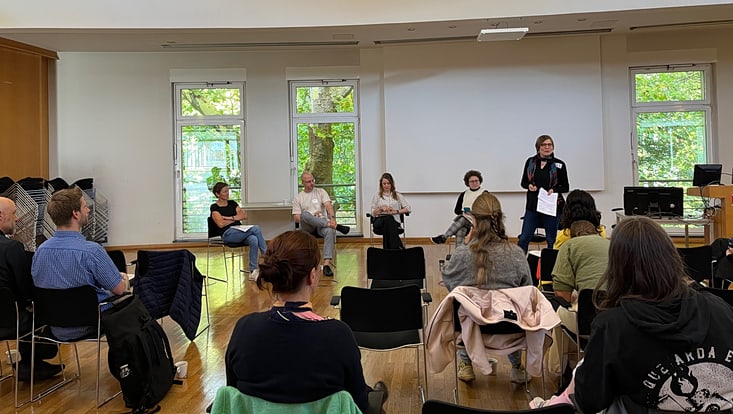Transfer-orientated DLEPresentations of the interim results of the Data-driven Solutions for the Smart City Hamburg project
16 June 2022

Photo: Karsten Bergmann
On 15 June 2022, the interim results of all use cases in the Data-driven Solutions for the Smart City Hamburg (D²S²C) project were presented. These are being worked on by the students in collaboration with Hamburger HOCHBAHN, HSV/Future Dock and Landesbetrieb Geoinformation und Vermessung, which provide data for this purpose and are in continuous dialogue with the students.
The aim of the project is to promote students' data literacy, which is supported by analysing and working on practical challenges by developing intelligent prototypes. The project is characterised by a high degree of interdisciplinarity and a wide range of opportunities for co-design and is open to all students of the MIN faculty.
"We are delighted with the success of the project and are pleased to have given students the opportunity to put what they have learnt into practice. The presentations of the interim results show that practical and independent learning and working in groups in collaboration with the cooperation partners can lead to a real contribution to digitalisation and the development of smart cities", says Marten Borchers from the Business Informatics, Socio-Technical System Design (WISTS) working group, who is supervising the project.
The students are working on a total of four use cases. For example, in collaboration with HSV/Future Dock, they are investigating how indoor navigation in the stadium can be made possible using a 3D model developed with computer vision methods in order to identify the shortest routes to the seats or similar and to support simulations for emergencies, maintenance and servicing. In the field of mobility, the students are developing two prototypes to predict the range of e-buses at Hamburg's HOCHBAHN using sensor and weather data for planned routes, for example, by calculating the energy requirement on the basis of regression models. Furthermore, accident hotspots in the bus operations of Hamburg HOCHBAHN are identified by analysing the locations and causes of accidents using a heat map in order to support preventive measures that make bus operations even safer. The fourth use case is accompanied by the State Office for Geoinformation and Surveying and deals with the automated evaluation of data from participation projects of the digital participation system (DIPAS) of the Ministry for Urban Development and Housing in order to utilise the information obtained in the context of urban planning. The focus here is particularly on the transparency and traceability of the algorithms and machine learning models.
The students' interim results show innovative solutions for dealing with challenges and thus offer approaches that are suitable for corporate practice and provide information on the use of data. As the project progresses, the students will continue to develop their prototypes and models in order to increase their reliability and/or integrate additional functions. The work can also be used as a basis for final theses, internships or for professional orientation.

